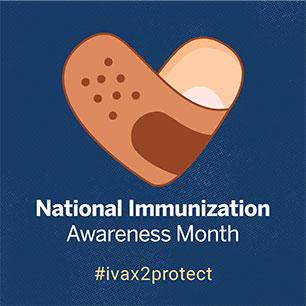August is National Immunization Awareness Month
July 04, 2022


Every August, we strive to raise awareness by highlighting the importance of vaccination for people of all ages. The reminder is even more critical this year as we reflect on impacts the COVID-19 pandemic has had on the healthcare system, particularly on vaccine coverage and vaccine misinformation.
1796: the first breakthrough
Edward Jenner, regarded as the “father of vaccines,” tested a method to protect against smallpox. He was able to demonstrate that, through taking material from a blister of a person infected with cowpox and inoculating it into another person’s skin, he was able to provide effective and safe protection from smallpox.
Since then, large-scale vaccine production has become possible, and starting in the 1940s, routinely recommended vaccines were developed.
Extraordinary 20th century achievements
Vaccines are one of the top public health achievements of the 20th century. Immunizations save up to 3 million lives annually. There has been a dramatic decrease in childhood morbidity and mortality due to vaccine- preventable diseases following the introduction of vaccines.
Eradicating smallpox
Vaccinations have led to the eradication of smallpox. In the 1950s, Jonas Salk invented the polio vaccine. At the time, poliomyelitis was a significant fear. In 1954 alone, polio killed over 1300 Americans and left more than 8000 paralyzed.
Eradicating polio
Following introduction of the vaccine, deaths due to polio plummeted and now polio has been eliminated in the United States and most of the world. Along those same lines, deaths due to pertussis decreased from over 4000 annually, prior to the vaccine, to 4 in the year 2021. Deaths due to diphtheria have fallen from 2000 per year to 0.
Furthermore, sequelae of certain diseases have drastically decreased. Incidence of congenital rubella syndrome dropped from 20,000 cases in 1964 to 1 case in 2021. These are tremendous achievements that seemed nearly impossible only a few decades ago. However, there is still work to be done before we reach the full potential of vaccines.
Vaccine-preventable diseases: still a threat
A social movement of public health vaccine opposition has been growing in recent years, further fueled by misinformation spread throughout the COVID-19 pandemic.
One study demonstrated that 1 in 15 parents in the US are hesitant about routine childhood vaccines and this rate is even higher with respect to the influenza vaccine: about 1 in 4.
Decreased and delayed vaccinations
Vaccine hesitancy and misinformation have led to stagnating vaccine coverage and even declining vaccine coverage rates in some areas. The vaccination rates for children in the United States are persistently sub-optimal despite the fact that the cost of vaccinations is covered for all children through private insurance or the Vaccines for Children Program. In places where vaccine coverage rates have declined, outbreaks have occurred.
The COVID-19 pandemic has caused wide scale disruptions to the health care system, including childhood immunization services worldwide. These disruptions have affected more than 80 million children globally, leaving children at risk for vaccine preventable diseases.
Multiple studies have shown a decrease in vaccination rates or delay in vaccinations during the pandemic:
- Childhood vaccination rates and the proportion of children up to date with their vaccines was lower in 2020 compared to the pre-pandemic period.
- Data from UNICEF and the World Health Organization revealed the first effects of these vaccine gaps – measles cases jumped by 79% in the first two months of the year 2022.
What can we do to increase vaccination rates again?
Parents report their child’s physician as the most trusted information source regarding vaccinations. Pediatricians are uniquely positioned to address parental hesitancy regarding routine childhood vaccines. Education regarding the necessity, safety, and effectiveness of vaccines is paramount in decreasing parental concern surrounding vaccines. This applies to the COVID-19 vaccine as well.
Help stop false information & myths
There has been an enormous amount of false information and myths surrounding the COVID-19 vaccine. COVID-19 vaccination can prevent severe illness as well as multisystem inflammatory syndrome (MIS-C) in children. It is important to educate families that the benefits of the COVID-19 vaccination significantly outweigh any known and potential risks.
Other practical strategies to help increase vaccination rates include:
- Proactively reaching out to remind families about well child checks and vaccinations through phone calls, text messages, or even portal-based reminders.
- Using sick visits, whenever possible, as an opportunity to catch up children and adolescents on missing vaccinations.
- Advocating for vaccines on a larger level, such as supporting expanded vaccination requirements, to help maintain high immunization coverage in schools and the larger communities.
Routine childhood immunizations are fundamental to individual and societal health.
It is now more important than ever for us, as healthcare providers, to proactively engage families, advocate for timely vaccination, and be the source of vaccine information for our patients in order to close gaps in vaccine coverage.
References:
- SeyedAlinaghi, S., Karimi, A., Mojdeganlou, H., Alilou, S., Mirghaderi, S. P., Noori, T., Shamsabadi, A., Dadras, O., Vahedi, F., Mohammadi, P., Shojaei, A., Mahdiabadi, S., Janfaza, N., Keshavarzpoor Lonbar, A., Mehraeen, E., & Sabatier, J. M. (2022). Impact of COVID-19 pandemic on routine vaccination coverage of children and adolescents: A systematic review. Health science reports, 5(2), e00516. https://doi.org/10.1002/hsr2.516
- DeSilva MB, Haapala J, Vazquez-Benitez G, et al. Association of the COVID-19 Pandemic With Routine Childhood Vaccination Rates and Proportion Up to Date With Vaccinations Across 8 US Health Systems in the Vaccine Safety Datalink. JAMA Pediatr. 2022;176(1):68–77. doi:10.1001/jamapediatrics.2021.4251
- Roush SW, Murphy TV, Vaccine-Preventable Disease Table Working Group AT. Historical Comparisons of Morbidity and Mortality for Vaccine-Preventable Diseases in the United States. JAMA. 2007;298(18):2155–2163. doi:10.1001/jama.298.18.2155
- https://www.cdc.gov/pertussis/downloads/pertuss-surv-report-2021_PROVISIONAL.pdf
- Jenssen BP, Fiks AG. COVID-19 and Routine Childhood Vaccinations—Identifying Gaps and Informing Solutions. JAMA Pediatr. 2022;176(1):21–23. doi:10.1001/jamapediatrics.2021.4248
